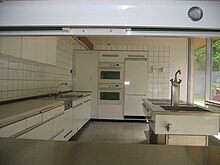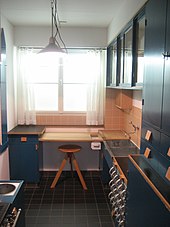Equipped kitchen
A fitted kitchen is the equipping of a kitchen with fixed, standardized furniture in terms of size and function. The Frankfurt kitchen , which was initiated by Ernst May in 1926 and worked out by the Viennese architect Margarete Schütte-Lihotzky, is considered the archetype of the fitted kitchen .
The advantages of the built-in kitchen are short commutes, a more rational design of work processes, good utilization of the available space and the possibility of accommodating a large number of equipment to shorten work processes.
Up until the beginning of the industrial revolution , the kitchens had brick-built open hearths with chimneys . These stoves have been replaced by individual portable cast table stoves made by artisans and factories . Individual kitchen furniture (table stove, sideboard , individual refrigerator , dining table , baking trough ) had the advantage of being able to be taken along when moving house. The fitted kitchen, in turn, replaced the kitchen equipment made up of such individual pieces.
At around the same time, the material Resopal was created , which was subsequently often used for this kitchen furniture.
history

So-called pantry kitchens, designed from a rational point of view , were mainly used in travel catering , for example in zeppelins and in dining cars. In Christine Frederick's book Rational Household Management from 1921, the routes in the kitchen are shown for the first time using a thread model. After measuring the distances, the optimal arrangement of the kitchen elements resulted.
The basic version of the Frankfurt kitchen was designed for a room of only 6.5 m² and was separated from the living room by a sliding door. The distance between the stove - which already had a hood - and the dining table was only three meters, and the surfaces to be cleaned were reduced to a minimum. Beech wood with an insensitive coating was used as the surface, the work surface was covered with linoleum . The Frankfurt kitchen was installed in around 10,000 apartments and an unknown number of individual houses within the first four years. Particularly well-known abroad and declared a role model, the cuisine from Frankfurt was largely ignored domestically. Established kitchen suppliers continue to rely on representative kitchen buffets. It was only after 1945 that the fitted kitchen caught on in Germany. In the 1950s, the so-called add -on cupboards occupied a certain intermediate position between the fitted kitchen and the familiar kitchen buffet . It was a buffet-like cupboard that consisted of several components that could be set up individually and placed on top of one another, depending on the space and financial possibilities of the buyer.
The development of the so-called Swedish kitchen began in the 1930s after the Frankfurt kitchen was shown at the Stockholm exhibition in 1930. The first kitchen standard was decided in 1950 and was based on the basic module 60 cm × 60 cm. In the following years, architects such as FW Dassbach developed various standard structures such as the “social work kitchen”, which were used in social housing, among other things. The concise and monofunctional design of the floor plan of kitchen rooms in new residential buildings made other forms of kitchen use such as the eat-in kitchen impossible. In contrast to the Frankfurt kitchen, the Swedish kitchen is usually made of inexpensive materials such as chipboard and medium-density fibreboard (MDF), the fronts and work surfaces are provided with laminated materials such as Formica . The dimension known from Sweden prevailed as the construction depth. In the GDR, however, a shallower depth was considered the standard. The width of the elements is also usually 60 centimeters; There are also special sizes for confined spaces.
From the 1970s onwards, the term “workbench” was used in the kitchen and is used in one source as a synonym for a preparation table; the magazine Md Interior Design Architecture described an Italian model as “workbenches and tool cabinets for the kitchen”.
From the late 1980s onwards, there was a trend towards the American-style open kitchen and, in the 1990s, towards the “modular kitchen”. With this, avoiding free spaces and gaps, as well as hiding functions and devices (such as extractor hoods) no longer play a major role.
construction
Most fitted kitchens are assembled from standard modules for cost reasons. Upper and lower cabinets are typical, often with a tiled area in between. While built-in kitchens were once based on the device width and depth of 60 cm (especially stoves and dishwashers ), today it is mainly the manufacturers of kitchen furniture who often adhere to the 60 dimension, because devices are now available in a variety of sizes between 45 and 70 cm. Some kitchen plans also include working depths of 65 to 70 cm, so that pre-wall installations can be integrated more easily into the kitchen unit. In Switzerland, element widths of 55 centimeters are still widespread and in use (" CH standard ").
A “handle-free kitchen” is a kitchen whose drawers and doors have no handles, but a continuous handle bar. The doors are held by concealed hinges; pin hinges are preferred in metal kitchens. The magnetic lock is rare (because it is complex), the frame and the door are provided with an internal magnetic profile strip to close tightly.
materials

The Frankfurt kitchen was still made of various types of wood, the wall cupboard had large panes and the bins were made of the then more expensive material aluminum. Cheap substitutes were not used. From the 1930s to the 1950s, steel kitchens were advertised, they could not prevail against the cheaper chipboard kitchens.
Since the post-war period, however, fitted kitchens have mostly been made from chipboard. Fronts are veneered, foiled, laminated or lacquered or, more recently, covered with sheet metal and foils. Doors are sometimes made of solid wood or aluminum profiles with a glass insert. The back walls and backs are mostly untreated, so that moisture and vapors can leave their traces here as well as on the edges. Some providers do without wood-based materials entirely and use stainless steel to build fitted kitchens . As a trend, unusual materials such as glass fiber reinforced plastic (GRP), ceramics and concrete are repeatedly used . Recycled materials are sometimes used in the interior (lining), for example cardboard or textiles, which, like wood-based materials, however, rely on adhesives.
In a study by Öko-Test in 2004 on the pollution of wood-based materials and their adhesives in kitchens, the manufacturer Bulthaup was rated “satisfactory”, on par with Poggenpohl and better than SieMatic, which received “unsatisfactory”. Limit values can be adhered to on a plate; if a large number of the plates are installed, you still inhale a large amount of the pollutants. In the distribution (e.g. kitchen house or catalog) there is usually no indication of the ingredients.
ergonomics
In addition to shortening the distances, ergonomics are also increasingly important, for example when it comes to the height of the worktop, washing up or frequently used devices. For example, it makes more sense to raise the dishwasher than the oven, as the dishwasher is used more often.
See also
Individual evidence
- ↑ Made to measure? - From DIN standards & body sizes , script to the WDR series Quarks & Co, PDF
- ↑ Agreement: Central organ of the food-pleasure-restaurants union , No. 29/1978 p. 23
- ^ Based on a kitchen by "Alberti Cucine di Alberti A & F, sno, Bovisio Masciago", MD. Furniture interior design, No. 28/1982
- ↑ Where can I get a non-toxic kitchen? ( Memento from September 6, 2014 in the Internet Archive )
- ↑ "When the new fitted kitchen stinks to heaven" in: Badische Zeitung



